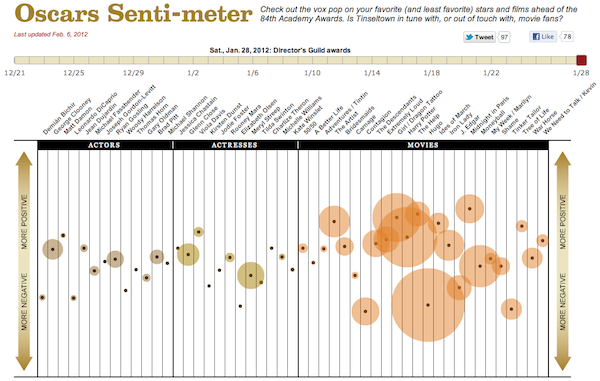

For all of the pageantry, glamour, and prestige of award season, it can be rather ordinary — even mundane — particularly for the people and companies that cover the trail of celebrity. The pattern’s familiar, from the late-fall buzz to the Christmas prestige releases to the nominations and finally the awards themselves. So, if you’re a news outlet that puts a lot of effort into entertainment, how do you shake things up?
If you’re the The Envelope, which exists as a website and weekly print supplement, is the Times answer to how to feed both an increased general interest in awards season, but also readership in the entertainment industry itself.
“We’re sort of in this unusual position where we cover the Oscar race as any newspaper might for the general reader, but then we have a whole constituency of hometown readers who consider this their lifeblood,” LA Times film editor Julie Makinen told me.
What the Times did, Makinen said, was try to create a site that both covers awards and gives multiple perspectives on the competition. What they created was a vertical that in some ways approaches the Oscars the way ESPN or Yahoo approaches fantasy sports: blow out the coverage; give the insider-y details; put as much data analysis behind it as possible.
One example would be what they call the Oscar Senti-meter, a tool that mines tweets for how the public feels about the various Oscar categories and contenders from day to day. The Times worked with IBM and the Annenberg Innovation Lab at the University of Southern California to create the sentiment-analysis tool, which gauges positive and negative reactions using language-processing software. For instance, Makinen says it tells you “a lot of people on Twitter thought Tinker, Tailor, Soldier, Spy was very confusing but still love Gary Oldman.” The Oscars are perfect fodder for an effort like this, since opinions typically run strong (WHERE IS GOSLING?). “This tool now allows us to tap into a much larger ocean of comments about this and examine it in an analytical way,” Makinen said.
Similarly the Heatmeter attempts a statistical approach to measuring the momentum of any given movie, actor, actress, or director. Using an in-house points system that assigns different values to things like awards (Oscars > Golden Globes > Screen Actors Guild, etc.), the meter tries to put data behind the anecdotal notion that The Artist and Meryl Streep are going to win their respective categories. “Everyone in Hollywood likes to talk about the horse race and momentum,” Makinen said.
Aside from its innovation merits, The Envelope also opens up another avenue for for studios, talent agencies, and others to advertise. (Think of those “For your consideration” ads you see everywhere this time of year.) But The Envelope is also a response to competition in the entertainment-reporting market. While the Times has long had to deal with the likes of Variety and The Hollywood Reporter, these days it contends with sites like The Wrap and Indie Wire, not to mention entertainment coverage from The Huffington Post and The Daily Beast among others. While Makinen wouldn’t go into specifics, she said The Envelope sees a healthy amount of traffic, which, considering the Times is breaking records for pageviews and other marks, means its probably doing okay.
The competition is a good thing, Makinen said, as it forces organizations to be creative in how they pursue their awards coverage. At the end of the day, there are only so many things George Clooney can say in pre-award interviews, which is why readers are looking for sites that offer more than the norm, she said. “This time of year in particular, it can feel like we don’t have anything fresh to give our readers,” Makinen said. “These kind of things can help do that, and set us apart from other publications as the same time.”